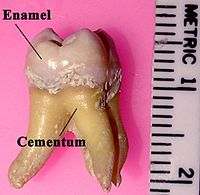
Photo from wikipedia
The constant and gradual apposition of the enamel during odontogenesis forms different histological structures on the tooth, including the perikymata, which appear on the crown surface as ridges between two… Click to show full abstract
The constant and gradual apposition of the enamel during odontogenesis forms different histological structures on the tooth, including the perikymata, which appear on the crown surface as ridges between two imbrication lines. Although they are e nameldependent structures described in various scientific texts and publications, they are not included in the enamel-dependent hist ological terms published in the Terminologia Histologica . The aim of this study was to analyze the term perikymata from a linguistic point of view and propose it as a new histological term. The word perikymata is derived from the Greek words perí 'around'+ kyma, 'wave', introduced by Preiswerk in 1895. Although the term is descriptive in itself, concentrating only information about the structure in a single w ord, as the terminology establishes, this does not indicate its location. We propose the term perikymata enamelis (perikymata of the enamel) be added. Although proposing new terms that are more in line with the International Federation of Associations of Anatomists (IFAA) and i ts terminology poses great challenges, a term is not just a word that makes reference to a morphological structure, it is also a unit of langu age, a means of communication, which in this case unites the morphological community in a single language.
Journal Title: International Journal of Morphology
Year Published: 2017
Link to full text (if available)
Share on Social Media: Sign Up to like & get
recommendations!